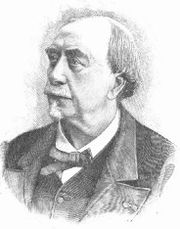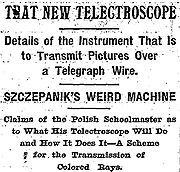
Telectroscope
Encyclopedia
The telectroscope was the first non-working prototype (i.e. conceptual model) of a television
Television
Television is a telecommunication medium for transmitting and receiving moving images that can be monochrome or colored, with accompanying sound...
or videophone
Videophone
A videophone is a telephone with a video screen, and is capable of full duplex video and audio transmissions for communication between people in real-time...
system. The term was used in the 19th century to describe science-based systems of distant seeing.
The name and its concept came into being not long after the telephone was patented in 1876, and its original concept evolved from that of remote facsimile reproductions onto paper, into the live viewing of remote images.
Figuier's imaginary telectroscope

Louis Figuier
Louis Figuier was a French scientist and writer. He was the nephew of Pierre-Oscar Figuier and became Professor of chemistry at L'Ecole de...
in 1878 to popularize an invention wrongly interpreted as real and incorrectly ascribed to Alexander Graham Bell
Alexander Graham Bell
Alexander Graham Bell was an eminent scientist, inventor, engineer and innovator who is credited with inventing the first practical telephone....
. Figuier was probably misled by the article "The Electroscope" published in The New York Sun of 29 March 1877, as well as a published letter in the journal Nature
Nature
Nature, in the broadest sense, is equivalent to the natural world, physical world, or material world. "Nature" refers to the phenomena of the physical world, and also to life in general...
in April 1878. Written under the pseudonym "Electrician", the New York Sun article claimed that "an eminent scientist", whose name had to be withheld, had invented a device whereby objects or people anywhere in the world "could be seen anywhere by anybody". According to the article, the device would allow merchants to transmit pictures of their wares to their customers, the contents of museum collections would be made available to scholars in distant cities, and (combined with the telephone) operas and plays could be broadcast into people's homes.
In reality, the imagined "telectroscopes" described in the articles had nothing to do with the device being developed by Dr. Bell and his assistant Charles Sumner Tainter
Charles Sumner Tainter
Charles Sumner Tainter was an American scientific instrument maker, engineer and inventor, best known for his collaborations with Alexander Graham Bell, Chichester Bell, Alexander's father-in-law Gardiner Hubbard, and for his significant improvements to Thomas Edison's phonograph, resulting in the...
which was christened with the ambiguous name photophone
Photophone
The photophone, also known as a radiophone, was invented jointly by Alexander Graham Bell and his then-assistant Charles Sumner Tainter on February 19, 1880, at Bell's 1325 'L' Street laboratory in Washington, D.C...
. The photophone was actually a wireless optical telephone that conveyed audio conversations on modulated lightbeams, the precursor for today's fiber-optic communication
Fiber-optic communication
Fiber-optic communication is a method of transmitting information from one place to another by sending pulses of light through an optical fiber. The light forms an electromagnetic carrier wave that is modulated to carry information...
s. Bell and Tainter would receive several patents in 1880/1881 for their then cutting-edge invention (master ), which ironically used the same selenium
Selenium
Selenium is a chemical element with atomic number 34, chemical symbol Se, and an atomic mass of 78.96. It is a nonmetal, whose properties are intermediate between those of adjacent chalcogen elements sulfur and tellurium...
materials in its receivers that created the initial excitement surrounding the telectroscope's proposals.
Further developments

Constantin Senlecq
Constantin Senlecq was a French scientist and inventor who is credited with the invention of telectroscope. He worked independently of the American inventor George R. Carey , who came up with a similar idea at approximately the same time .Telectroscope was the first prototype television...
, George R. Carey
George R. Carey
George R. Carey was an American inventor born in 1851. He was among the first to propose the telectroscope using the photo-electric properties of selenium as a means for transmitting images - a precursor to modern television.George R...
, Adriano de Paiva
Adriano de Paiva
Adriano de Paiva was a Portuguese scientist who was one of the pioneers of telectroscope. He worked at the Politechnical Academy of Porto and conducted research into selenium as a material to transmit images....
, and later Jan Szczepanik
Jan Szczepanik
Jan Szczepanik was a Polish inventor....
, who with Ludwig Kleiberg obtained a British patent (patent nr. 5031) for his device in 1897. Szczepanik's telectroscope, which was never actually exhibited and likely never existed, was covered in the New York Times on April 3, 1898, where it was described as "a scheme for the transmission of colored rays". Szczepanik's experiments fascinated Mark Twain
Mark Twain
Samuel Langhorne Clemens , better known by his pen name Mark Twain, was an American author and humorist...
, who wrote a fictional account of his work in his short story From The Times of 1904. Both the imagined "telectroscope" of 1877 and Mark Twain's fictional
Science fiction
Science fiction is a genre of fiction dealing with imaginary but more or less plausible content such as future settings, futuristic science and technology, space travel, aliens, and paranormal abilities...
device had an important effect on the public. They also provided feedback to the researchers.
Neither the fictional nor the real nineteenth century prototype telectroscopes were real television systems. "Telectroscope" was eventually replaced by the term "television", most probably coined by Constantin Perskyi
Constantin Perskyi
Constantin Perskyi was a Russian scientist who is credited with coining the word television in a paper read at the International World Fair in Paris on 25 August 1900 at the 1st International Congress of Electricity which ran from 18 to 25 August. At the time, he was Professor of Electricity at...
in 1900.

The Telectroscope art installation
In the recent era, 'telectroscope' was the name of an modern art installation constructed by Paul St GeorgePaul St George
Paul St George is a London based multimedia artist and sculptor, best known for The Telectroscope, an art installation visually linking London and New York....
in 2008, which provided a visual link between London and New York City.
In May–June 2008, artist Paul St George exhibited outdoor interactive video
Interactive art
Interactive art is a form of installation-based art that involves the spectator in a way that allows the art to achieve its purpose. Some installations achieve this by letting the observer or visitor "walk" in, on, and around them; Some others ask the artist to become part of the artwork.Works of...
installations linking London and New York City as a fanciful telectroscope. According to the Telectroscope's back story, it used a transatlantic tunnel
Transatlantic tunnel
A transatlantic tunnel is a theoretical tunnel which would span the Atlantic Ocean between North America and Europe and would carry mass transit of some type—trains are envisioned in most proposals.Using advanced technologies, speeds of are envisaged....
started by the artist's fictional great-grandfather, Alexander Stanhope St. George. In reality, the installation used two video camera
Video camera
A video camera is a camera used for electronic motion picture acquisition, initially developed by the television industry but now common in other applications as well. The earliest video cameras were those of John Logie Baird, based on the electromechanical Nipkow disk and used by the BBC in...
s linked by a VPN connection to provide a virtual tunnel across the Atlantic. The connection used links of between 8 and 50 Mbit/s and the images were transmitted using MPEG-2
MPEG-2
MPEG-2 is a standard for "the generic coding of moving pictures and associated audio information". It describes a combination of lossy video compression and lossy audio data compression methods which permit storage and transmission of movies using currently available storage media and transmission...
compression. The producer of this spectacle was the creative company Artichoke
Artichoke (creative company)
Artichoke, also known as the Artichoke Trust, is a London-based British company and registered charitable trust that stages arts spectacles and live events...
, who previously staged The Sultan's Elephant
The Sultan's Elephant
The Sultan's Elephant was a show created by the Royal de Luxe theatre company, involving a huge moving mechanical elephant, a giant marionette of a girl and other associated public art installations. In French it was called La visite du sultan des Indes sur son éléphant à voyager dans le temps...
in London.

Display window
A display window is a window in a shop displaying items for sale or otherwise designed to attract customers to the store. Usually, the term refers to larger windows in the front façade of the shop...
in New York and Los Angeles as well as by Maurice Benayoun
Maurice Benayoun
Maurice Benayoun is a French pioneer new-media artist and theorist based in Paris. His work employs various media, including video, immersive virtual reality, the Web, wireless technology, performance, large-scale urban art installations and interactive exhibitions.-Biography:Born in Mascara,...
with The Tunnel under the Atlantic
The Tunnel under the Atlantic
The Tunnel under the Atlantic is an interactive art installation by Maurice Benayoun. The visitors were invited to dig, inside memory, a virtual tunnel between Pompidou Centre in Paris and the Museum of Contemporary Art in Montreal in 1995....
between the Pompidou Centre
Centre Georges Pompidou
Centre Georges Pompidou is a complex in the Beaubourg area of the 4th arrondissement of Paris, near Les Halles, rue Montorgueil and the Marais...
in Paris and the Museum of Contemporary Art
Musée d'art contemporain de Montréal
The Musée d'art contemporain de Montréal is a contemporary art museum in the Place des Arts complex, Montreal, Quebec, Canada. The collection includes over 7,000 works of art by more than 1,500 artists , covering contemporary art in Quebec in particular and Canada in general, as well as...
in Montreal
Montreal
Montreal is a city in Canada. It is the largest city in the province of Quebec, the second-largest city in Canada and the seventh largest in North America...
(1995).
See also
- Coaxial Cable -History
- History of radioHistory of radioThe early history of radio is the history of technology that produced radio instruments that use radio waves. Within the timeline of radio, many people contributed theory and inventions in what became radio. Radio development began as "wireless telegraphy"...
- History of televisionHistory of televisionThe history of television records the work of numerous engineers and inventors in several countries over many decades. The fundamental principles of television were initially explored using electromechanical methods to scan, transmit and reproduce an image...
- TelephonoscopeTelephonoscopeA telephonoscope was an early concept of videophone and television, conceptualized in the late 1870's through the 1890's. It was mentioned in various early science fiction works such as Le Vingtième siècle. La vie électrique and other works written by Albert Robida...

